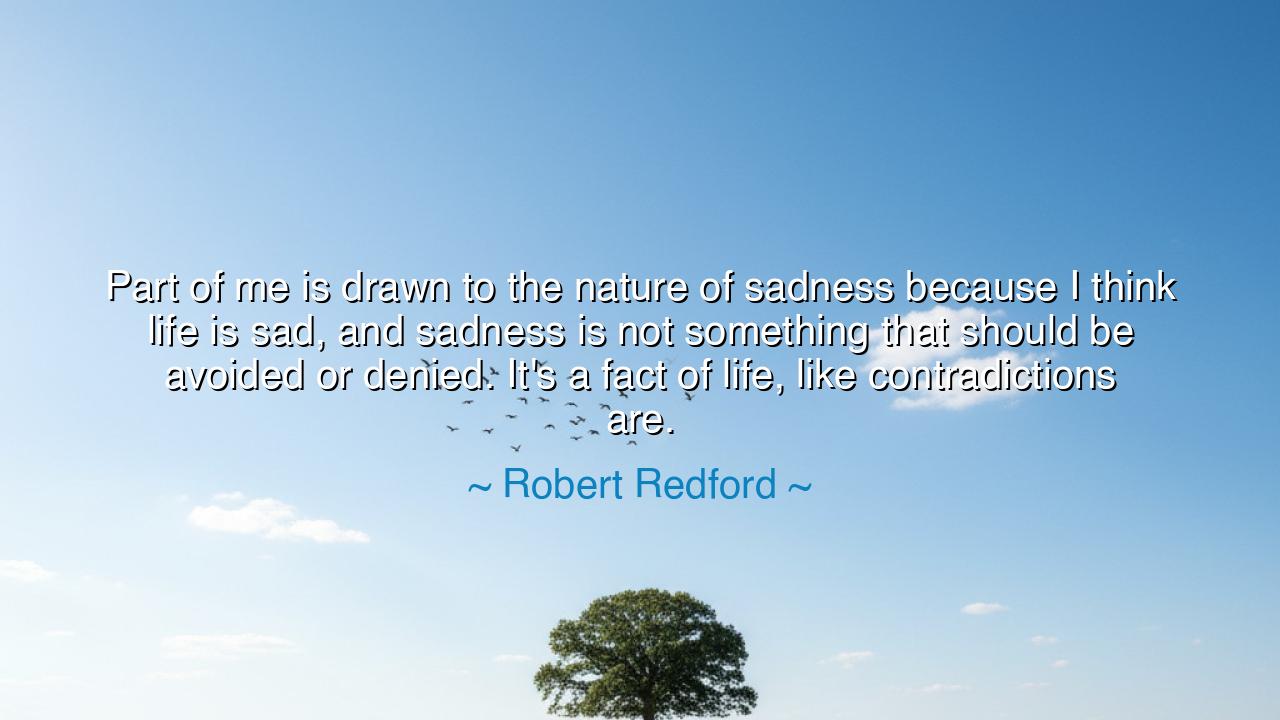
Part of me is drawn to the nature of sadness because I think life
Part of me is drawn to the nature of sadness because I think life is sad, and sadness is not something that should be avoided or denied. It's a fact of life, like contradictions are.






When Robert Redford said, “Part of me is drawn to the nature of sadness because I think life is sad, and sadness is not something that should be avoided or denied. It’s a fact of life, like contradictions are,” he was not surrendering to despair—he was honoring the truth of existence. His words flow from the wisdom of one who has lived deeply, who has seen both triumph and loss, beauty and decay, and has understood that sadness is not the enemy of joy but its companion. Like shadow defines light, sorrow gives meaning to happiness. To deny sadness is to deny half of life itself. Redford’s reflection is an echo of the ancient understanding that the soul grows not in constant pleasure, but in the fertile soil of grief and contradiction.
The nature of sadness, as he calls it, is something both inevitable and sacred. It is born from awareness—the awareness that everything changes, that time moves forward and takes from us what we love. The ancients called this impermanence, and they revered it as the teacher of humility and gratitude. When we weep for something lost, we are not merely mourning its end; we are acknowledging its value. Redford’s wisdom lies in his refusal to turn away from this truth. He recognizes that to live authentically is to feel completely, to embrace joy and sorrow alike as parts of one divine rhythm.
Throughout history, the great minds and artists have shared this reverence for sadness. The philosopher Aristotle wrote that those touched by melancholy were often closest to genius, for they saw the world’s complexity more clearly. The poet Rumi spoke of sorrow as the doorway to understanding, saying, “The wound is the place where the light enters you.” And the Japanese masters of mono no aware—the “pathos of things”—believed that to feel sadness at the fleeting nature of beauty was the highest form of sensitivity. Robert Redford stands in that same tradition. His words remind us that sadness is not a flaw to be fixed, but a truth to be witnessed and respected.
Redford also speaks of contradictions, placing them side by side with sadness, as if to say that both are essential to life’s mystery. Indeed, the world is full of opposites that coexist: love and loss, strength and frailty, beginnings and endings. To live well is to learn not to erase these contradictions, but to hold them in balance. The river flows because it moves between its banks; music exists because silence surrounds sound. So too does the human spirit grow because it moves between joy and sorrow. In this, Redford’s insight becomes almost spiritual: to accept the contradictions of life is to live in harmony with its truth.
There is a quiet heroism in accepting sadness rather than fleeing from it. Modern culture often urges us to numb pain, to chase pleasure endlessly, to hide our tears. But those who face sadness with courage—who let themselves grieve, reflect, and grow—gain a depth of soul that cannot be imitated. Think of Abraham Lincoln, whose life was marked by personal loss and melancholy, yet who led a nation with empathy and vision. His sadness did not weaken him; it made him wise. In the same way, Redford’s words remind us that the world does not need hearts of stone—it needs hearts that have been broken and mended, hearts that understand both the cost and the beauty of being alive.
The meaning of Redford’s reflection, then, is not pessimism but liberation. To accept sadness is to free oneself from the illusion of constant happiness. It is to say, “I will feel all that life offers, without shame.” When we accept sadness as natural, it loses its power to terrify us. We become like sailors who understand the sea—not fearing its storms, but respecting its depths. In every sorrow, there lies a hidden gift: compassion, perspective, tenderness, or the simple knowledge that we have survived.
Let this be the lesson passed down to those who walk the path of life: do not flee from sadness, and do not curse the contradictions within you. They are not flaws—they are the marks of being fully human. When you feel sorrow, do not hide it; let it teach you patience. When you face contradiction, do not despair; let it sharpen your understanding. Life is not meant to be tidy, nor without pain. It is vast and unpredictable, like the skies Redford so often filmed against—the clouds and sunlight mingling together. To embrace sadness is to embrace truth, and to live truthfully is the greatest act of courage a soul can perform.






AAdministratorAdministrator
Welcome, honored guests. Please leave a comment, we will respond soon